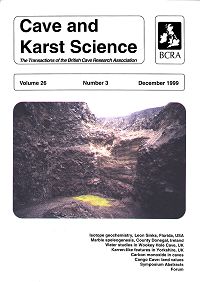
BCRA > Publications > Cave & Karst Science> Contents
Scroll down for Editorial | Papers | Reports | Forum | Thesis Abstracts
 Isotope geochemistry, Leon Sinks, Florida, USA
Isotope geochemistry, Leon Sinks, Florida, USA
Marble
speleogenesis,County Donegal, Ireland
Water studies in Wookey Hole Cave,
UK
Karren-like features in Yorkshire, UK
Carbon monoxide in caves
Cango Cave: land values
Symposium Abstracts
Forum
Cover Photo by John Gunn: Fluorescein dye injection at the opencast fluorspar mine on Dirtlow Rake, Castleton, Derbyshire, UK.
In England, Scotland and Wales the permission of the Environment Agency must be sought prior to introducing any artificial tracer substance into the environment, otherwise there will be a risk of prosecution. If there is any possibility of the tracer emerging into a public water supply the relevant Water Company must also be consulted.
Before injection of the tracer, it is essential to place fluocapteurs, and to collect water samples, to determine the natural luminescence background. Detergents, some animal feedstuffs, and other domestic and industrial pollutants can introduce substances into the water that could be interpreted as all the common tracers OBA, fluorescein and rhodamine.
It is suggested that cavers should seek the support and advice of an academic, or other individual, with a track record of successful tracing work and access to a spectrofluorimeter. Otherwise it is considered that the most reliable method for tracing in non-peaty water is to use fluorescein and activated charcoal fluocapteurs. Users are warned of false positives caused by contamination by pollutants, or by cross-contamination from dye retained from a previous test; and they are also warned about apparent negatives caused by insufficient time being allowed for slow dye throughput, inattention to possible multiple outputs, or failure to monitor "unlikely" outputs at much greater distances. An example is given of failure to monitor the Bradwell springs in tracing from Dirtlow Rake, the workers having assumed that drainage was only to Peak Cavern.
It is also suggested that traces should not be published until they have been replicated in further operations.
Uranium and strontium isotopes are used in this investigation as tracers to determine the water sources of sinkholes. Uranium isotopes in water have been shown to be useful as tracers to distinguish sources of mixed waters. Isotopic ratios of strontium are often used as a natural flow tracer, as well, because the 87-Sr/86-Sr ratio of natural waters in Fisher Sink, Fisher Rise Sink, and Lost Stream Sink, which originate from the Water Table aquifer (Pliocene-Pleistocene), have higher 87-Sr/86-Sr ratios and lower 234-U/238-U ratios. The waters of Big Dismal and Hammock come from the Upper Floridan aquifer, which has lower 87-Sr/86-Sr ratios and higher 234-U/238-U ratios.
This page created by Dr John D. Wilcock j.wilcock[at]bcra... and edited by David Gibson.